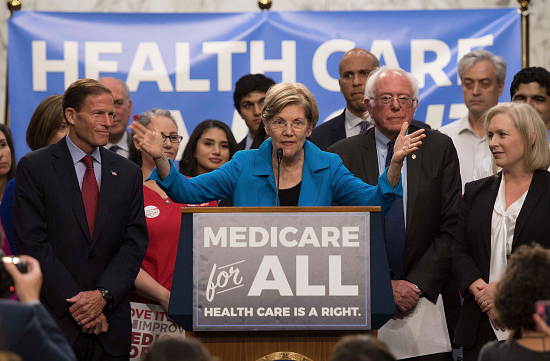The Effect of changing the Medicare Eligibility Age on the Health of the Near-Retirement Population
Raising the eligibility age for Medicare, the third largest program in the federal budget, could lead to a large reduction in the federal budget deficit; however, the effect of this change on the health of the near-retirement population is unclear. Using Health and Retirement Study (HRS) dataset, I measure the effect of a change in Medicare eligibility age on the health of the elderly population by estimating a dynamic discrete choice model of health and retirement that endogenizes the health investment decisions. Using Forward Simulation and Conditional Choice Probability estimator (CCP), I incorporate a large, multidimensional state space consisting fixed, unobserved heterogeneity that helps me to employ a detailed model to address the health and welfare concerns of the change in the eligibility age of the Medicare. I find that labor supply, life expectancy, and mental health will be affected positively in response to an increase in the Medicare eligibility age. The welfare effect, however, is negative and there is some evidence of cost transfers from Medicare to the Social Security Program...

Policy Implications: The findings of this research provide crucial insights for policymakers considering changes in Medicare eligibility age. By understanding the positive effects on labor supply, life expectancy, and mental health, policymakers can make informed decisions to balance budgetary considerations with the well-being of the near-retirement population.
Value to Private Industries: Private industries in healthcare can benefit from understanding the potential impacts of changes in Medicare eligibility age. This research offers valuable information for health-related businesses to anticipate shifts in demand and tailor their services accordingly.
Labor Unions and Covid-19: Beyond the Workplace
Person-to-person transmission in the workplace is thought to play a crucial role in the spread of COVID-19. Labor unions are among the largest institutions in the United States, and their role in regulating employee-employer relations is hard to ignore. Costly efforts to contain the virus combined with the monopoly and collective voice faces of unions emphasize the role of unions in shaping the workforce’s response to the pandemic, where the effects can be amplified by the further transmission of the virus beyond the workplace. We utilize state-level data and a dynamic spatial probability model to quantify the total effect of both economic activities and union membership. We find that increasing economic activity by recruiting 1,000 new employees from unemployed individuals would lead to 368 more COVID-19 cases by November 2020 and before the vaccine rollout. However, increasing the union size by 1,000 while keeping the employment level constant would lead to 111 fewer COVID-19 cases in the same period... Paper

Policy Implications: This research highlights the potential role of labor unions in mitigating the spread of COVID-19. Policymakers can leverage this information to formulate strategies that involve unions in the overall public health response, extending the benefits beyond the workplace and contributing to community well-being.
Value to Private Industries: Industries with a focus on workforce management can use this research to understand the impact of union size on COVID-19 cases. Implementing measures to collaborate with unions for safer work environments can be a valuable strategy for private industries to protect their employees and maintain business continuity.
Measuring Health in HRS dataset using Bayesian Approach
This paper provides a measure of the physical health for the near retirement people based on the binary responses of individuals to the sets of questions... Using three sets of questions: Activities of daily living (ADL), Lower Body Mobility (LBM) and Upper Body Agility (UBA), I employ the Item Response Theory and using Bayesian approach estimate the individual distribution of health for each individual in the Health and Retirement Survey (HRS) sample of 2008. The Analysis of 17,217 sets of individual responses shows that LBM and UBA affect the combined health index (Full Index) more strongly and ADL has a weak effect on the health index. While the correlation between the full measure of functional limitation and LBM and UBA is 0.92 and 0.84 respectively, the correlation between functional limitation and ADL is only 0.5...

Policy Implications: The application of Bayesian approach and Item Response Theory in measuring health in HRS dataset provides a robust method for policymakers to assess physical health in near-retirement populations. This method allows for a more nuanced understanding of health based on specific sets of questions, enabling targeted health interventions.
Value to Private Industries: Industries involved in health assessments and interventions can benefit from the advanced measurement techniques presented in this research. Implementing similar Bayesian approaches can enhance the accuracy of health assessments, providing valuable information for private companies engaged in health-related services.
Comparing LBD and OJT Human Capital Accumulation
Investigating the differences in human capital accumulation through Learning by Doing (LBD) and On-the-Job Training (OJT) using structural estimation methods on US data. Co-authored with Michael Keane. This research employs advanced econometric techniques to analyze the impact of different modes of skill acquisition on individual and aggregate human capital development. By structurally estimating the parameters, the study aims to provide nuanced insights into the distinct pathways and outcomes associated with LBD and OJT.

Policy Implications: Understanding the relative effectiveness of LBD and OJT in human capital accumulation can inform education and training policies. Policymakers can use these insights to design targeted programs that align with the most efficient methods of skill development, potentially improving workforce productivity and economic growth.
Value to Private Industries: Businesses and industries can benefit from this research by optimizing their training programs. Recognizing the effectiveness of LBD or OJT in specific contexts can help companies tailor their human resource strategies, fostering a skilled workforce that adapts to evolving industry demands.
The Impact of Permanent vs Temporary Price Change in Healthcare
Investigating the impact of permanent and temporary price changes in healthcare. Co-authored with Serena Yu. This work explores the consequences of different types of price changes in the healthcare sector, distinguishing between permanent and temporary shifts. The study aims to provide insights into the long-term and short-term effects on various health outcomes and healthcare utilization...

Policy Implications: Understanding the differential impacts of permanent and temporary price changes in healthcare is crucial for policymakers designing pricing strategies. This research offers valuable insights into the potential consequences of different pricing mechanisms, aiding in the development of policies that align with long-term health goals.
Value to Private Industries: Healthcare providers and insurance companies can use this research to tailor their pricing strategies for better health outcomes. The distinction between permanent and temporary price changes can guide industry practices to ensure sustainable and effective healthcare delivery.
TThe Gendered Impact of a Health Shock
Exploring the gendered effects of a health shock. Co-authored with Maryam Naghshnejad and David Johnstone. This ongoing research delves into the differential impact of health shocks across gender lines. By analyzing data and applying rigorous econometric methods, the study aims to uncover patterns and disparities in how individuals of different genders respond to unexpected health events...

Policy Implications: Understanding the gendered impact of health shocks is essential for designing targeted policies to address disparities. This research contributes to policymaking by shedding light on the unique challenges and responses to health shocks experienced by individuals of different genders.
Value to Private Industries: Private industries focused on healthcare, insurance, and wellness can leverage insights from this research to tailor their products and services to the specific needs of different genders during health shocks. This targeted approach can enhance the effectiveness and inclusivity of industry offerings.
The Effect of Cancer on Youth Education
Studying the effects of cancer on youth education. Co-authored with Maryam Naghshnejad. This research project focuses on understanding the educational consequences of a cancer diagnosis among young individuals. Through a combination of empirical analysis and theoretical modeling, the study aims to shed light on the educational pathways affected by cancer and identify potential interventions...

Policy Implications: This research provides policymakers with insights into the educational challenges faced by young individuals dealing with cancer. Policymakers can use this information to design targeted interventions and support systems to ensure continued access to education for this vulnerable population.
Value to Private Industries: Educational institutions and organizations focusing on youth development can collaborate with this research to implement supportive measures for students dealing with cancer. The findings can inform the development of programs and services that address the unique educational needs of this demographic.
Consistent Incorporation of Individual Level Characteristics into Models with Aggregate Level Health Outcomes
Developing models that incorporate individual-level characteristics into health outcome models at the aggregate level. Co-authored with Tom Mroz and Philip Gustavson. This collaborative work focuses on refining modeling techniques to ensure the consistent integration of individual-level characteristics into models examining aggregate health outcomes. The study aims to contribute methodological advancements to enhance the accuracy and relevance of health outcome predictions...

Policy Implications: Policymakers can benefit from improved health outcome models that consider individual-level characteristics. This research provides a methodological foundation for policies aimed at addressing aggregate health outcomes with a more nuanced understanding of individual factors.
Value to Private Industries: Health-related industries, research institutions, and policymakers can incorporate the refined modeling techniques presented in this research to improve the accuracy of predictions and interventions. The consistent incorporation of individual-level characteristics enhances the relevance of health models for private industry applications.
Imputing Censored Binary Health Data Using Poisson-Binomial Distribution
Proposing methods for imputing censored binary health data using Poisson-Binomial distribution. Co-authored with Tom Mroz and Golnoush Rahimzadeh. This ongoing project addresses the challenges of dealing with censored binary health data by introducing innovative imputation methods based on the Poisson-Binomial distribution. The study seeks to improve the accuracy and reliability of health data analyses in situations where certain information is systematically missing...

Policy Implications: Policymakers and health organizations can benefit from improved imputation methods for censored binary health data. This research provides a foundation for policies that address the challenges of missing health information, enhancing the accuracy of public health assessments.
Value to Private Industries: Companies involved in health data analysis, insurance, and healthcare research can leverage the innovative imputation methods proposed in this research. Enhancing the reliability of health data analyses contributes to more informed decision-making in various private industry applications.
